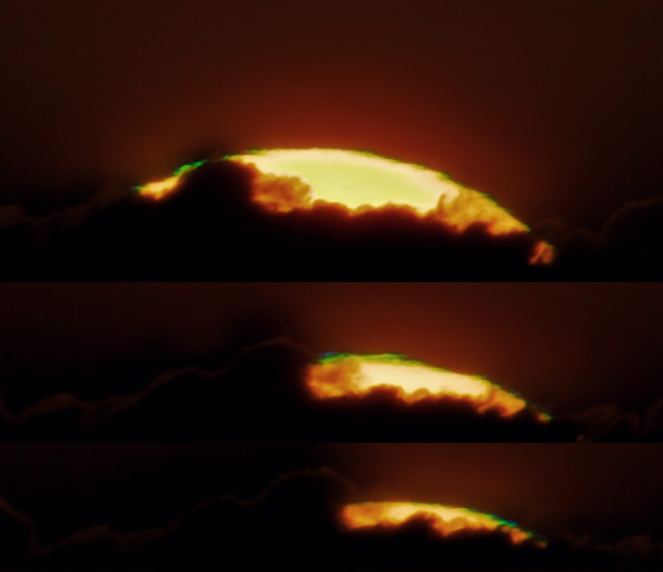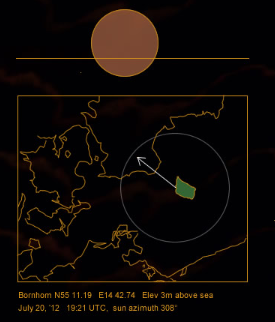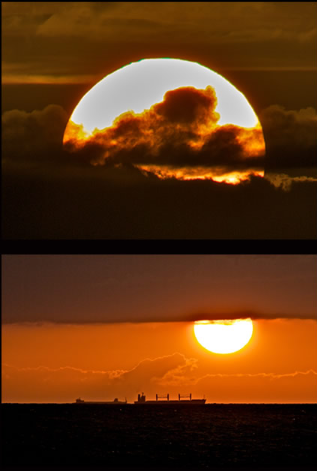OPOD - Cloud-top Green Flashes
OPOD - Cloud-top Green Flashes: A Rare and Mysterious Phenomenon
Have you ever witnessed the mesmerizing sight of the setting sun's rim flashing a vibrant shade of green, seemingly obscured by the tops of clouds? These elusive phenomena, known as cloud-top green flashes, have been captured in a stunning 30-second sequence by photographer Jesper Grønne from the Baltic Sea island of Bornholm, Denmark.
The Classical Green Flash and Mock-Mirage Flashes
The classical green flash is typically observed at the horizon as the very last sliver of the sun disappears. It occurs when the sun's rays are refracted across a layer of air warmed by the sea, resulting in an inferior mirage. Mirage conditions, characterized by strong temperature gradients between air layers, are essential for a green flash to be seen.
In addition to the classical green flash, there is another type called the mock-mirage flash. These flashes manifest as small, multiple, and transient green flashes on the upper limb of the sun when it is still partially above the horizon. They are produced by refraction across temperature inversion layers, where there is a kink in the normal atmospheric vertical temperature gradient, causing a layer of warmer air.
The Enigmatic Cloud-Top Flashes
Cloud-top flashes, on the other hand, are a rarer and less understood variation of the mock-mirage flash. It appears that these flashes occur when rays from the sun's upper limb barely graze the top of a cloud bank. Although Jesper Grønne's sequence captures this phenomenon, it is worth noting that the green flashes do not exclusively occur where obscuration by the cloud top begins. This suggests that certain parts of the cloud top may be thin and not readily visible.
The distinct shapes observed in the vertically compressed flash forms depicted in Grønne's images indicate the presence of inversion layer temperature gradients. Some flashes even exhibit tilting or curving, which could be attributed to atmospheric waves or temperature profile distortions induced by the cloud.
Unraveling the Mystery
While it is known that marine stratus clouds can be trapped by inversion layers, leading to green flashes at the top of these layers, this explanation does not entirely account for cloud-top flashes. The nature and underlying mechanisms of these rare phenomena continue to perplex researchers.
To gain further insights into cloud-top green flashes, it is crucial to study their occurrence in various atmospheric conditions and locations. Analyzing the characteristics of the cloud bank, such as its thickness and composition, may provide valuable clues about the conditions necessary for these flashes to manifest.
Conclusion
Cloud-top green flashes are a captivating atmospheric optics phenomenon that remains shrouded in mystery. Through the remarkable photography of Jesper Grønne, we catch a glimpse of these rare events, characterized by their vibrant green hues. While the classical green flash and mock-mirage flashes have been studied to some extent, cloud-top flashes present an intriguing puzzle that scientists and photographers alike strive to unravel. By delving deeper into the complexities of temperature gradients, atmospheric waves, and cloud dynamics, we may one day shed light on the enigmatic nature of cloud-top green flashes.

Cloud-top Flashes
The setting sun's rim flashes green, seemingly in those spots where it starts to be obscured by cloud tops.
A 30s sequence of a rare and poorly understood effect imaged by Jesper Gr�nne (The Art of Nature) from the Baltic Sea island of Bornholm, Denmark.
Images ©Jesper Gr�nne, shown with permission.

The classical green flash is at the horizon as the very last sliver of sun disappears. It is the result of the sun’s rays being refracted across a layer of air warmed by the sea and is an inferior mirage. Mirage conditions of some sort – strong temperature gradients between air layers – are essential for a flash to be seen.
Another type of green flash is the mock-mirage flash. These are small, multiple and transient flashes on the sun's upper limb when the disk is still partially above the horizon. They are produced by refraction across temperature inversion layers, kinks in the normal atmospheric vertical temperature gradient where there is a layer of warmer air.
Cloud-top flashes are likely a form of mock-mirage flash but they are rather rarer and are not properly understood. They seem to occur as rays from the sun’s upper limb just graze the top of a cloud bank. Jesper Grønne’s sequence shows this happening but, as often is the case, the green flashes do not seem to be exclusively where obscuration by the cloud top is starting. It may be, however, that some parts of cloud top are thin and not visible.
The vertically compressed flash forms, especially in the second image suggest inversion layer temperature gradients. Some other flashes are tilted or curved and indicate waves in the atmosphere or temperature profile distortions induced by the cloud.
Marine stratus can be trapped by inversion layers and in that case green flashes at the layer top are expected. But that does not fully explain cloud-top flashes.
Video - 40MB, download before opening in Quicktime to enable frame by frame viewing.

Left: 19 minutes before the cloud-top sequence above the sun passed behind another cloud bank to emerge later from its base. The upper limb shows perhaps a green limb or weak flashes indicative of another inversion layer.
 Right: Severe enhancement of the cloud-top flash sequence shows possible hints of blue flashes.
Right: Severe enhancement of the cloud-top flash sequence shows possible hints of blue flashes.
Note: this article has been automatically converted from the old site and may not appear as intended. You can find the original article here.
Reference Atmospheric Optics
If you use any of the definitions, information, or data presented on Atmospheric Optics, please copy the link or reference below to properly credit us as the reference source. Thank you!
-
<a href="https://atoptics.co.uk/blog/opod-cloud-top-green-flashes/">OPOD - Cloud-top Green Flashes</a>
-
"OPOD - Cloud-top Green Flashes". Atmospheric Optics. Accessed on April 24, 2024. https://atoptics.co.uk/blog/opod-cloud-top-green-flashes/.
-
"OPOD - Cloud-top Green Flashes". Atmospheric Optics, https://atoptics.co.uk/blog/opod-cloud-top-green-flashes/. Accessed 24 April, 2024
-
OPOD - Cloud-top Green Flashes. Atmospheric Optics. Retrieved from https://atoptics.co.uk/blog/opod-cloud-top-green-flashes/.